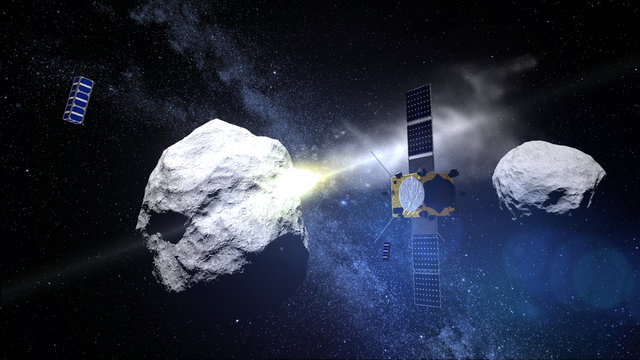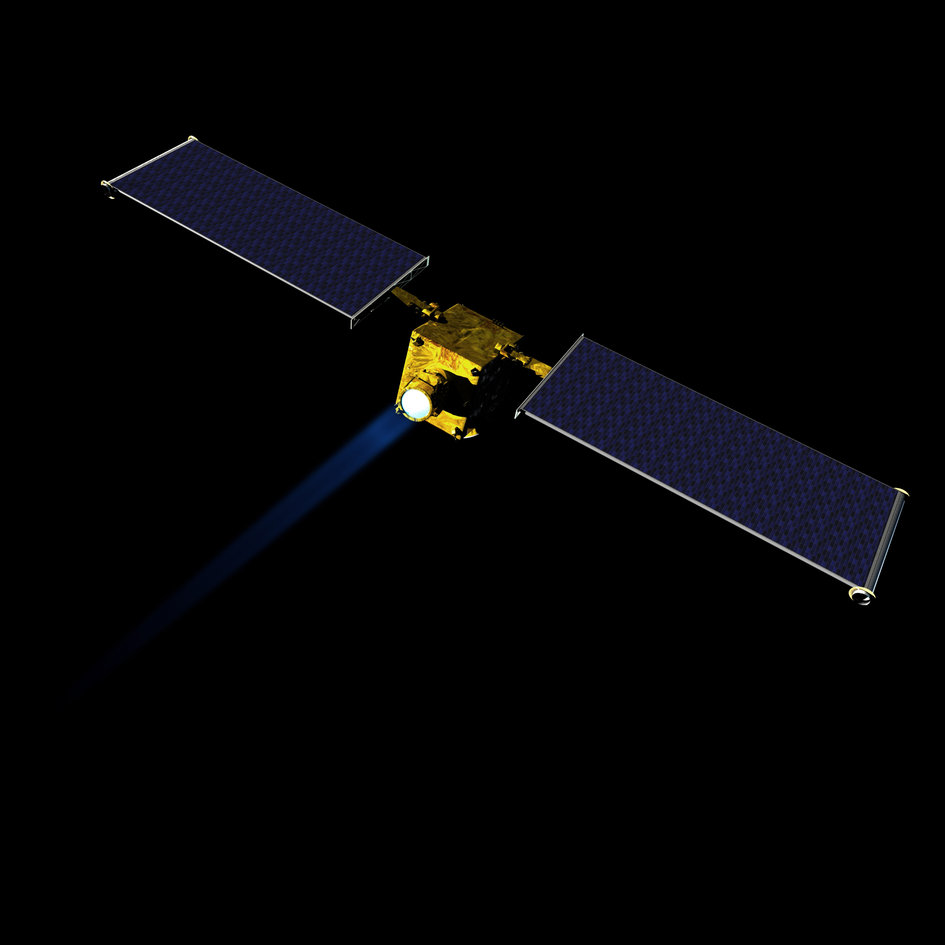Astronomy - Future of asteroid deflection mission to be decided soon

Decisions on the future of a joint robotic mission between NASA and the European Space Agency to demonstrate the ability to deflect an asteroid on a collision course with Earth have been put off until later this year after European governments declined to fully fund their part of the project in December.
The two-spacecraft mission was to have included probes provided by NASA and ESA to launch in 2020 on a nearly two-year trek to Didymos, a half-mile-wide (800-meter) near-Earth asteroid that has a companion moon.
The U.S.-built spacecraft would be an impactor, aiming to crash into Didymos’s 500-foot-wide (150-metre) moon. A European mission would arrive at Didymos before the U.S. impactor — dubbed the Double Asteroid Redirect Test, or DART — and observe the collision and take before-and-after observations to gauge its effects.
Scientists want to know how the kinetic energy from DART’s impact changes the mini-moon’s trajectory around the main body of Didymos. The measurements could verify techniques needed to deflect a future asteroid on a path to strike Earth.
Mission planners have said either component of the joint mission — NASA’s DART spacecraft or ESA’s Asteroid Impact Mission — could stand on their own scientific merits if one of the space agencies dropped out of the project.
Representatives from ESA’s member states met in Lucerne, Switzerland, last month to lay out the space agency’s budget for the next few years, and the AIM mission was left for cancellation after European governments secured funding to extend their involvement in the International Space Station to 2024, complete payments for the ExoMars rover mission to launch to the red planet in 2020, and pursue other programs.
Now ESA managers are studying a scaled-back, less expensive version of the AIM mission called AIMlight. The objective is to reduce the European part of the mission’s cost from around 250 million euros ($266 million) to as low as 150 million euros ($160 million), according to Ian Carnelli, who manages the AIM mission for ESA.
The AIM mission was always considered “low-cost,” Carnelli said in a Jan. 12 meeting of NASA’s Small Bodies Advisory Group, a committee of scientists tasked to act as a forum for researchers focused on asteroids, comets and related solar system objects.
In his presentation last week, Carnelli said ESA member states needed to commit at least 105 million euros ($112 million) to the AIM project last month to keep the mission’s development on track through 2019.
“We got to about 70 (million euros), which was very encouraging before the funding from some major coutnries were diverted to the ISS,” Carnelli said. “I’m glad ISS was indeed confirmed until 2024. Unfortunately, we have to pay for it.”
Jan Woerner, ESA’s director general, told reporters in an annual beginning-of-the-year press conference Wednesday that he did not consider the AIM mission canceled, despite statements made immediately after the conclusion of the ministerial meeting in Switzerland on Dec. 2.
“We are still looking into it,” Woerner said. “We are looking into how to finance it in the traditional way, and we are also looking into new possibilities, but right now — today — industry is still working on it. There is still a contract going on, but (it) would not be sufficient for the overall mission.”
The original concept for the Asteroid Impact and Deflection Assessment, or AIDA, mission — the name of the joint NASA/ESA project — called for AIM to launch in October 2020 on a year-and-a-half journey to Didymos, where the spacecraft would arrive in May 2022 to survey the asteroid and its moon for more than six months.

NASA’s DART spacecraft would take off some time between December 2020 and May 2021, and perhaps as late as August 2021 if managers give up an opportunity to fly by another asteroid en route to Didymos, according to Cheryl Reed, DART’s project manager at the Johns Hopkins University Applied Physics Laboratory.
DART would be steered on its path to Didymos by a new-generation xenon-ion thruster with three times the power of the ion engines on NASA’s Dawn spacecraft currently orbiting the dwarf planet Ceres, the largest object in the asteroid belt. A new roll-out solar panel design would unspool to a span of around 41 feet (12.5 metres) to provide electricity.
The spacecraft would target Didymos’s moon, nicknamed Didymoon, in October 2022 with a closing velocity of more than 13,000 mph (6 kilometres per second), generating enough energy at impact to drive the object slightly off its current orbit.
“What we intend to do is to change the orbital period of Didymoon, which is on the order of 11.9 hours,” Reed said Jan. 12 in a presentation to the Small Bodies Advisory Group. “We believe that we will change it seven minutes or more … Our requirement is 73 seconds, and we will be able to see that from the ground.”
Didymos would be around 6.8 million miles (11 million kilometres) from Earth at the time of DART’s expected impact, close enough for meaningful ground observations to judge whether the collision had the intended effect.
“We have this wonderful opportunity that Mother Nature has given us, with this binary system with its closest approach in October 2022, which is the current schedule that we are on in order to be able to have that as our impact event,” Reed said. “On that date, we’ll be able to measure the deflection from the ground globally with 1-to-2-metre-class telescopes, as well as with the big guys.”
If AIM is loitering nearby, it will offer an even better look.
“Hopefully, AIM will be on station,” Reed said. “They will go before us, be able to do pre-characterization, observe the event on station, and do post-characterization.”
DART is designed to carry just one instrument: A long-range, high-resolution camera based on the LORRI imager aboard NASA’s New Horizons spacecraft that flew by Pluto in 2015. The camera would aid DART’s navigation toward the target and collect close-up imagery on final approach.
Reed said the DART mission passed two NASA reviews last year, but a NASA decision gate required to pursue the project further was delayed from October to March 9 due to what she described as paperwork issues.
In the meantime, DART’s development continues with several months of “bridge funding” until the March decision to enter the next phase of the project — Phase B — and keep the mission on schedule for a late 2020 or early 2021 liftoff.
While NASA officials weigh the future of the DART mission, ESA managers hope to salvage the AIM observer.
“Planetary defense, as it is officially called, is an important issue,” Woerner said Wednesday. “Also, for the general public, it seems to be an important one, so we are trying to get something (done).”
“There are a number of countries that actually are calling for a mission like AIM, and even more important (than) that, the need and interest to have a planetary defense demonstration was recognized, and this is a first in Europe,” Carnelli said.
“ESA’s been working on this subject for at least 12 years, and we never got to this point, to this level,” Carnelli said.
Woerner added that ESA is “looking for a lighter version” of AIM, with a reduced science payload.
The full-scale AIM mission would have consisted of a 1,700-pound (770-kilogramme) spacecraft with a ground-penetrating radar to study the interiors of Didymos and its companion, a hyperspectral multi-color camera, a laser topographic mapper, a German-built lander, and at least two deployable CubeSats designed to make independent measurements.
Carnelli said the less expensive “AIMlight” mission concept, if approved, would also launch in October 2020, but only carry a single imaging instrument, either a spare off-the-shelf navigation camera left over from a previous project, or a more capable color camera in development by Planetary Resources, a U.S.-based company established in 2010 to develop technologies to eventually mine asteroids.
The smaller spacecraft would have a launch weight of around 660 pounds (300 kilogrammes), according to Carnelli.
The reduced-cost AIMlight proposal could also gather information on the structure and mass of Didymos and its moon using radio signals passed between the spacecraft and Earth.
AIMlight could launch on a small European Vega-C booster, or share a ride on a larger rocket, Carnelli said.
The DART mission would likely launch on a shared rocket with a commercial communications satellite, separating in an elongated geostationary transfer orbit around Earth and using its ion thruster to escape toward Didymos.
The AIMlight industrial study should be finished by June, when it will be reviewed by ESA, and if approved, proposed to the agency’s member states for final funding decisions, Carnelli said.
At last month’s budget meeting, Luxembourg, Romania, Spain, Portugal, Poland and the Czech Republic were among AIM’s financial backers. Germany, one of the largest funders of ESA, was also interested in the mission, but withdrew much of its support in favor of the space station, Carnelli said.
That could change if a viable AIMlight proposal comes forward.
“I am not giving up because the member states — the ministers — asked me not to give up,” Woerner said. “This is an important message. They asked me in their last statements, when it was clear we did not get enough subscriptions, they told me, ‘Don’t give up. Look for a solution.’ And I am looking, and not only sitting and waiting.”
No comments:
Post a Comment